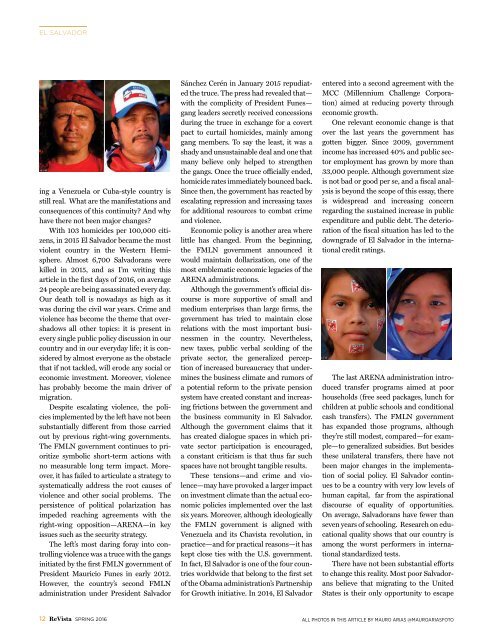EL SALVADOR
8clowSgZh
8clowSgZh
Create successful ePaper yourself
Turn your PDF publications into a flip-book with our unique Google optimized e-Paper software.
<strong>EL</strong> <strong>SALVADOR</strong><br />
ing a Venezuela or Cuba-style country is<br />
still real. What are the manifestations and<br />
consequences of this continuity? And why<br />
have there not been major changes?<br />
With 103 homicides per 100,000 citizens,<br />
in 2015 El Salvador became the most<br />
violent country in the Western Hemisphere.<br />
Almost 6,700 Salvadorans were<br />
killed in 2015, and as I’m writing this<br />
article in the first days of 2016, on average<br />
24 people are being assassinated every day.<br />
Our death toll is nowadays as high as it<br />
was during the civil war years. Crime and<br />
violence has become the theme that overshadows<br />
all other topics: it is present in<br />
every single public policy discussion in our<br />
country and in our everyday life; it is considered<br />
by almost everyone as the obstacle<br />
that if not tackled, will erode any social or<br />
economic investment. Moreover, violence<br />
has probably become the main driver of<br />
migration.<br />
Despite escalating violence, the policies<br />
implemented by the left have not been<br />
substantially different from those carried<br />
out by previous right-wing governments.<br />
The FMLN government continues to prioritize<br />
symbolic short-term actions with<br />
no measurable long term impact. Moreover,<br />
it has failed to articulate a strategy to<br />
systematically address the root causes of<br />
violence and other social problems. The<br />
persistence of political polarization has<br />
impeded reaching agreements with the<br />
right-wing opposition—ARENA—in key<br />
issues such as the security strategy.<br />
The left’s most daring foray into controlling<br />
violence was a truce with the gangs<br />
initiated by the first FMLN government of<br />
President Mauricio Funes in early 2012.<br />
However, the country’s second FMLN<br />
administration under President Salvador<br />
Sánchez Cerén in January 2015 repudiated<br />
the truce. The press had revealed that—<br />
with the complicity of President Funes—<br />
gang leaders secretly received concessions<br />
during the truce in exchange for a covert<br />
pact to curtail homicides, mainly among<br />
gang members. To say the least, it was a<br />
shady and unsustainable deal and one that<br />
many believe only helped to strengthen<br />
the gangs. Once the truce officially ended,<br />
homicide rates immediately bounced back.<br />
Since then, the government has reacted by<br />
escalating repression and increasing taxes<br />
for additional resources to combat crime<br />
and violence.<br />
Economic policy is another area where<br />
little has changed. From the beginning,<br />
the FMLN government announced it<br />
would maintain dollarization, one of the<br />
most emblematic economic legacies of the<br />
ARENA administrations.<br />
Although the government’s official discourse<br />
is more supportive of small and<br />
medium enterprises than large firms, the<br />
government has tried to maintain close<br />
relations with the most important businessmen<br />
in the country. Nevertheless,<br />
new taxes, public verbal scolding of the<br />
private sector, the generalized perception<br />
of increased bureaucracy that undermines<br />
the business climate and rumors of<br />
a potential reform to the private pension<br />
system have created constant and increasing<br />
frictions between the government and<br />
the business community in El Salvador.<br />
Although the government claims that it<br />
has created dialogue spaces in which private<br />
sector participation is encouraged,<br />
a constant criticism is that thus far such<br />
spaces have not brought tangible results.<br />
These tensions—and crime and violence—may<br />
have provoked a larger impact<br />
on investment climate than the actual economic<br />
policies implemented over the last<br />
six years. Moreover, although ideologically<br />
the FMLN government is aligned with<br />
Venezuela and its Chavista revolution, in<br />
practice—and for practical reasons—it has<br />
kept close ties with the U.S. government.<br />
In fact, El Salvador is one of the four countries<br />
worldwide that belong to the first set<br />
of the Obama administration’s Partnership<br />
for Growth initiative. In 2014, El Salvador<br />
entered into a second agreement with the<br />
MCC (Millennium Challenge Corporation)<br />
aimed at reducing poverty through<br />
economic growth.<br />
One relevant economic change is that<br />
over the last years the government has<br />
gotten bigger. Since 2009, government<br />
income has increased 40% and public sector<br />
employment has grown by more than<br />
33,000 people. Although government size<br />
is not bad or good per se, and a fiscal analysis<br />
is beyond the scope of this essay, there<br />
is widespread and increasing concern<br />
regarding the sustained increase in public<br />
expenditure and public debt. The deterioration<br />
of the fiscal situation has led to the<br />
downgrade of El Salvador in the international<br />
credit ratings.<br />
The last ARENA administration introduced<br />
transfer programs aimed at poor<br />
households (free seed packages, lunch for<br />
children at public schools and conditional<br />
cash transfers). The FMLN government<br />
has expanded those programs, although<br />
they’re still modest, compared—for example—to<br />
generalized subsidies. But besides<br />
these unilateral transfers, there have not<br />
been major changes in the implementation<br />
of social policy. El Salvador continues<br />
to be a country with very low levels of<br />
human capital, far from the aspirational<br />
discourse of equality of opportunities.<br />
On average, Salvadorans have fewer than<br />
seven years of schooling. Research on educational<br />
quality shows that our country is<br />
among the worst performers in international<br />
standardized tests.<br />
There have not been substantial efforts<br />
to change this reality. Most poor Salvadorans<br />
believe that migrating to the United<br />
States is their only opportunity to escape<br />
12 ReVista SPRING 2016 ALL PHOTOS IN THIS ARTICLE BY MAURO ARIAS @MAUROARIASFOTO


